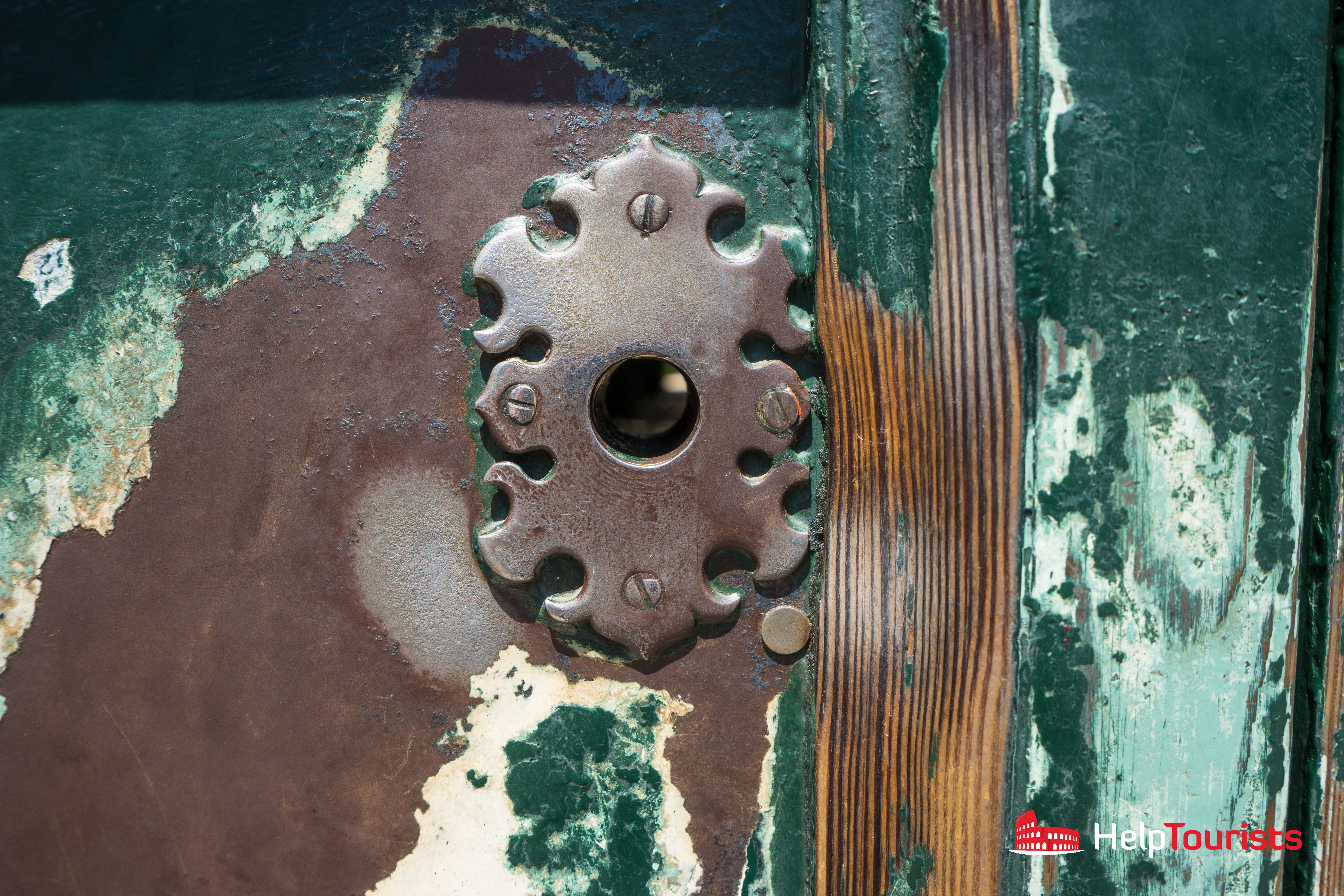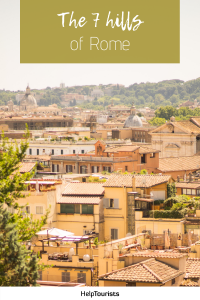7 hills of Rome. Rome was not built in one day, but on seven hills. The history of the Seven Hills of Rome is not just a legend that states that the city was originally built on seven different Roman hills. For you, it is a good place to start exploring Rome and learning more about the city. So if you are planning a visit to Rome, you should consciously include one or the other of the hills in your sightseeing program. As part of the historic center of the city, the seven hills of Rome house some of the most important monuments. For an overview and inspiration for your hilly exploration tour of Rome, see the following article.

7 Hills of Rome at a glance – A city built on seven hills
The famous seven hills on which Rome was founded are located to the east of the Tiber. In 387 BC they were surrounded by the Servian Wall in order to limit the city of Rome at that time. The Seven Hills of Rome found in the writings of Cicero and Plutarch are:
- Capitol, 50 m
- Palatine, 51 m
- Quirinal, 61 m
- Viminal, 60 m
- Aventine, 47 m
- Caelius, 50 m
- Esquiline, 65 m
7 Hills of Rome – The Capitol: The cradle of Europe
Let’s start with the most famous of the seven hills of Rome. And the Capitol, which is called on Italian Campidoglio or Monte Capitolino. Theodor Heuss counts the Capitol – next to the Acropolis in Athens and Golgotha in Jerusalem – to the hills on which Europe was founded. It is located next to the Monumento a Vittorio Emanuele II (which is often jokingly called Typewriter) in Piazza Venezia.

For most of you, the term Capitol is the seat of the US Congress in Washington, D.C. come in, who was named after the Roman model. Strictly speaking, the American government building is not named after the Roman hill, but its ancient main temple, the Capitolium, that once stood on the Capitol.
Today, the Capitol Hill is dominated by the Capitoline Museums and Capitol Square. This adorns the Italian 50 cent coin and is one of the most beautiful squares in Rome. He was designed by none other than the artist Michelangelo himself.

Right next to it, and reached via a large flight of steps, you will find the Basilica of Santa Maria in Aracoeli, dating back to the 6th century. Personally, I especially love the view from the Capitol Hill. Here you can see that the Roman Forum is like a valley between the two hills of Rome. On the left side of the Senatorial Palace (the building, as you enter the square from the steps of Piazza Venezia), you come to a view point from where you can see the Roman Forum and look to the Palatine.
7 Hills of Rome – The Palatine: Origin of Ancient Rome
The list goes on with the Palatine. Access to this representative of the 7 hills of Rome is possible only through the Roman Forum. If you just want to watch, you can also look at the Palatine from afar. This is best done either from the Capitol Hill or Circus Maximus. By metro you can reach the Palatine with the line B via the stations Colosseo or Circo Massimo. The Palatine, which in Italian (colle) is called Palatino, is considered the part of Rome that was first populated.

Rome’s history starts, according to legend, in the year 753 BC. However, the first settlements on the Palatine date back to the 10th century BC. If one believes in the founding myth of the Eternal City, then Romulus and Remus should have argued over whether they want to found Rome on the Palatine, or the Aventine. Romulus emerged victorious, and with him won the Palatine as a place of foundation. At the time of the Romans settled on this of the seven hills of Rome above all the upper class.

There were built government temples and representative buildings on the Palatine. Because almost all the emperors wanted to build their villas where it all began. Among others, on the Palatine, you will find the remains of the palace complexes of Domus Augustana and the legendary Domus Aurea (the Golden House of Nero), to name only a few.
7 Hills of Rome – The Quirinal: the official residence of the President
The next of the seven hills of classical Rome that I would like to introduce to you is the Quirinal. This hill, which is called Quirinale in Italian, owes its present glory mainly to the fact that it houses the eponymous palace. Since 1947, it has been the seat of the President of the Italian Republic. However, before the 16th-century Quirinal Palace became the official residence of the President, it was the summer residence of the popes.

From 1870 it was even residence of the Italian kings. The changing of the guards, which takes place every day at 15:00 in the Piazza del Quirinale, is a reminder of this and is particularly attractive for tourists.
In addition, the view from the piazza to the dome of St. Peter’s Basilica is epic.

I would also like to recommend art lovers among you a visit to the Scuderie del Quirinale in via XXIV Maggio 16. Indeed, this museum exhibits a number of famous artworks of international standing. How you get there? Take metro line A to Barberini Fontana di Trevi or Repubblica Teatro dell’Opera. It is a short walk from there.
7 Hills of Rome – The Viminal: Spa, Opera and the Ministry of Interior
Continue to Viminale, the smallest of the seven hills. The name seems to derive from the presence of abundant willow trees and is known today for the presence of the eponymous palace. The Palace houses the Presidency of the Council of Ministers and the Italian Ministry of the Interior. In addition to the Ministry of the Interior, the Viminal also houses the Opera of Rome. Also the famous Baths of Diocletian and the Piazza della Repubblica with its Naiadas Fountain – which for me is one of the most beautiful fountains in Rome.
The seven hills of Rome – The Aventine: A hill full of beautiful surprises
The Aventine is located in the southwest of Rome. In ancient times, it was the Romans from the lower strata who lived here at first. This soon changed, however, and important buildings of Rome, such as temples, baths, and many residences of Roman aristocrats soon followed.

Today, the residential area around the southernmost of the seven hills of ancient Rome is rather upscale. At the foot of the Aventine, between him and the Palatine, is the Circus Maximus (metro line B). But the wealth on the slopes of the Aventine not only goes back to Roman times, on the contrary. On the hill you will find many churches and basilicas, most of which were built in the Middle Ages. For example, the Santa Prisca, Santa Sabina and the Basilica of the Holy Boniface and Alessio.

There are many good reasons to climb the Aventine Hill. The first is that you can enjoy a truly unique view of Rome from here through Rome’s most famous keyhole. More about the Aventine and the keyhole, you can read (in detail) in the text about the famous keyhole on the Aventine. Another reason is the visit to the Orange Garden, which overlooks the Tiber and offers a beautiful panoramic view of the city at sunset. Finally, on the slopes of the Aventine, the urban rose garden of Rome, one of the most beautiful parks in Rome.

The seven hills of Rome – The Caelius
It is located behind the Colosseum southeast of the Palatine and extends east to the Lateran, where the archbasilika of St. John Lateran stands.
Celio is home to interesting and little-known monuments: worth mentioning are the Caracalla Baths, the Basilica Santo Stefano with its unmistakable round shape, and then the Villa Celimontana, where every summer a fascinating jazz festival is celebrated. Moreover, on the Celio, hidden under the Basilica of St. John and Paul, are the remains of a Roman condominium. If you are from Via di San Gregorio is the road that connects the Colosseum and the Circus Maximus. If you turn off in the Piazza di San Gregorio in the small street Clivo di Scauro, then you come directly past the church and the Roman houses and get straight into the park of Villa Celimontana.
The seven Hills of Rome – The Esquiline
The Esquiline is the highest and largest of the 7 hills in Rome. Most visitors to Rome cross the Esquiline without even knowing it. Here is the Termini station, one of the main hubs of Roman public transport.

In Roman times there was a cemetery in the area where slaves and poor people were buried. Under Augustus, the district on and around the Esquiline became a populous and vibrant district. Even today, the area around the Esquiline Hill is a multi-ethnic district with its fulcrum, Piazza Vittorio.

Finally, the Esquiline is the hill in Rome, on which stands the most important Basilica of the Eternal City. The Basilica of Santa Maria Maggiore.
Social media
Become part of the HelpTourists community on Facebook! In our private group you can exchange ideas with other Rome lovers. Follow us on Instagram and Pinterest and get regular inspiration and insider tips for your next Rome trip!
Pin information about the 7 hills of Rome on Pinterest

This article contains referral links. There are no additional costs for you, but thanks to these links we get a small commission. This enables us to continue to work diligently on the website and always have the latest information from Rome ready for you. Thank you for your support!









